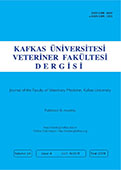
This journal is licensed under a Creative Commons Attribution-NonCommercial 4.0 International License
Kafkas Üniversitesi Veteriner Fakültesi Dergisi
2018 , Vol 24 , Issue 4
Investigation of the Calculus Microbiome in Canines and Felines Using Next-Generation Sequencing
1Department of Companion Animal and Wildlife Clinic, Faculty of Veterinary Medicine, Chiang Mai University, Chiang Mai 50100, THAILAND2Excellence Center in Veterinary Biosciences, Chiang Mai University, Chiang Mai 50200, THAILAND
3Department of Biology, Faculty of Science, Naresuan University, Phitsanulok 65000, THAILAND
4Department of Biology, Faculty of Science, Chiang Mai University, Chiang Mai 50200, THAILAND
5Department of Veterinary Biosciences and Veterinary Public Health, Faculty of Veterinary Medicine, Chiang Mai University, Chiang Mai 50100, THAILAND DOI : 10.9775/kvfd.2018.19690 The oral cavity of dogs and cats is colonized by hundreds of bacterial species. Here, we describe the bacterial composition in the dental calculus of dogs and cats. Dental calculus samples from 43 dogs and 4 cats were pooled into four different groups. Dogs were categorized into three groups: non-small breed dogs (NSB), non-brachycephalic small breed dogs (SB) and brachycephalic small breed dogs (SBb). The fourth group included cats. Bacterial communities were identified based on 16S rRNA sequencing (V3 and V4 hypervariable regions) with the Illumina platform. The numbers of operational taxonomic units (OTUs) identified in the three groups of dogs were 180, 190 and 150 and in NSB, SBb and SB, respectively, while in cats there were 111 OTUs. In dental calculus from both dogs and cats, the phylum Firmicutes had the highest proportion of read number, especially the class Clostridia. PCoA and UPGMA analysis revealed differences in the microbiomes of canine and feline calculus. Our findings demonstrated that the bacterial communities in calculus seemed to differ from those in other sites of the oral cavity. Calculus may serve as a potential habitßat for the growth of bacteria linked to canine and feline periodontal disease. Keywords : Bacteria, Cat, Dog, 16S rRNA analysis, Dental calculus











